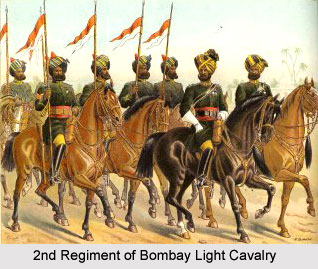 The 2nd Regiment of Bombay Light Cavalry was an erstwhile cavalry regiment of the Honourable British East India Company, which was raised in the year 1816 as the 2nd Native Troop of Cavalry. The battalion was a part of the army of Bombay Presidency in former British India. The Bombay Army was one of the 3 major Presidency Armies in British India. The armed forces of Bombay province consisted many esteemed units including the Bombay Grenadiers. The Presidency Armies initially operated under the British East India Company. But after the authorization of the Government of India Act 1858, the 3 British Presidency Armies were amalgamated to form the unified British Indian Army in the year 1903. The 2nd Regiment of Bombay Light Cavalry was also known as the 2nd Bombay Lancers Regiment and the 32nd Lancers.
The 2nd Regiment of Bombay Light Cavalry was an erstwhile cavalry regiment of the Honourable British East India Company, which was raised in the year 1816 as the 2nd Native Troop of Cavalry. The battalion was a part of the army of Bombay Presidency in former British India. The Bombay Army was one of the 3 major Presidency Armies in British India. The armed forces of Bombay province consisted many esteemed units including the Bombay Grenadiers. The Presidency Armies initially operated under the British East India Company. But after the authorization of the Government of India Act 1858, the 3 British Presidency Armies were amalgamated to form the unified British Indian Army in the year 1903. The 2nd Regiment of Bombay Light Cavalry was also known as the 2nd Bombay Lancers Regiment and the 32nd Lancers.
Military Operations of Governor General`s Bodyguard
The troops of the regiment were sent to Neemuch in the year 1857 and also participated at the Central India Campaign. Due to their significant services in the military operations, Captain James Blair, an officer of the unit, was awarded the Victoria Cross. Under the administrative authority of Lord Kitchener, the entire line of the former British Indian Army was restructured and re-organised in 1903. Consequently, the 2nd Regiment of Bombay Light Cavalry was renamed as the 32nd Lancers.
During the outbreak of the First World War, the 32nd Lancers were posted in Mesopotamia during the year 1916. The military unit was the first British troops to infiltrate Baghdad. Later in 1917, the cavalry regiment took part in the Battle of Istabulat, under the leadership of the commanding officer. The troops attacked an entrenched Turkish position and suffered heavy casualties.
Designations of Governor General`s Bodyguard
The 2nd Regiment of Bombay Light Cavalry occupied several designations through out its existence under the British Indian army. The chronology of the designations are mentioned as follows-
* 2nd Native Troop of Cavalry in 1816
* 2nd Regiment of Bombay Light Cavalry in 1817
* 2nd Regiment of Bombay Silladar Light Cavalry in 1861
* 2nd Regiment of Bombay Light Cavalry in 1861
* 2nd Bombay Lancers in 1883
* 32nd Lancers in 1903



















